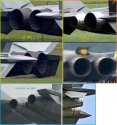Proof positiveTo admit externally - especially with only the exhaust visible - they are the same and as such it is not possible to know.
However since CAC specifically demanded a modified version of the trusted AL-31F with the gear-box relocated to the bottom of the engine for the J-10 that became the AL-31FN, since exactly the same was demanded for the FC-1/JF-17's engine when Klimov relocated the gear-box of its RD-33 to the bottom to develop the RD-93 ... I simply can't think that CAC uses an engine with its gear-box back on top as on the AL-31F or RD-33. Otherwise the J-10 and JF-17 could have easily used the original engines too.
As such ... only my estimated guess.
Deino
PS: by the way what's about these batch 02 J-15s ???
I'm speculating the dimension of the engine nacelle has already been fixed to that of the new engine and not the AL-31F/N, or whatever it currently is. This explains why a gab is left between the engine nacelle and the engine. This may be an indication that an engine change is going to happen sooner that later
Quite likely the case, (pun intended), the J-20 has likely been designed to take the WS-15, the engine nacelles are stressed skins that carry much of the load of the J-20, and it would involve a little work to "enlarge them", so the less of that the better, it would effect lots of other aspects of the airframe and dynamics?
I have speculated that the fuse was designed to accept the larger case without modification, the engine and cases being centered within the nacelle by the mounts which are comparatively simple to change or modify.

